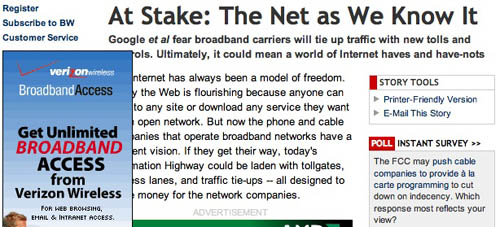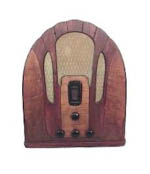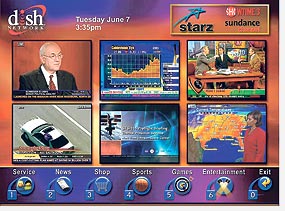Ten years after the initial signing of the Telecommunications Act of 1996, Congress is considering amending it. The original intention of the legislation was to increase competition by deregulating the telecommunication industry. The effects were gigantic, with a main result being that Regional Baby Operating Companies (RBOCs or Baby Bells) formed after the break up of the Ma Bell in 1984, merged into a handful of companies. Verzion nee Bell Atlantic, GTE, and NYNEX. SBC nee Southwestern Bell, PacTel, and Ameritech. Only now, these handful of companies operate with limited regulation.
On Tuesday, Congress heard arguments on the future of pricing broadband access. The question at hand is net neutrality, which is the idea that data transfer should have a single price, regardless of the provider, type or content of media being downloaded or uploaded. Variable pricing would have an effect on Internet companies as Amazon.com that use broadband networks for distributing their services as well as individuals. Cable companies and telecos such as Verizon, Comcast, Bell South, and AT&T are now planing to roll out tiered pricing. Under these new schemes, fees would be higher access to high-speed networks or certain services as downloading movies. Another intention is to charge different rates for downloading email, video, or games.
The key difference between opponents and proponents of net neutrality is their definition of innovation, and who benefits from that innovation. The broadband providers argue that other companies benefit from using their data pipes. They claim that by not being able to profit more from their networks, their incentive to innovate, that is, upgrade their systems, will decrease. While on the other side, firms as Vonage and Google argue the opposite, that uniform access spurs innovation, in terms of novel uses for the network. These kinds of innovations (video on demand) provide useful new services for the public, and in turn increase demand for the broadband providers.
 First, it is crucial to point that all users are paying for access now. Sen. Byron Dorgan of North Dakota noted:
First, it is crucial to point that all users are paying for access now. Sen. Byron Dorgan of North Dakota noted:
”It is not a free lunch for any one of these content providers. Those lines and that access is being paid for by the consumer.”
Broadband providers argue that tiered pricing (whether for services or bandwidth) will increase innovation. This argument is deeply flawed. Tier-pricing will not guarntee new and useful services for users, but it will guarantee short term financial gains for the providers. These companies did not invent the Internet nor did they invent the markets for these services. Innovative users (both customers and start-ups) discovered creative ways to use the network. The market for broadband (and the subsequent network) exists because people outgrew the bandwidth capacity of dial-up, as more companies and people posted multimedia on the web. Innovation of this sort creates new demands for bandwidth and increases the customer base and revenue for the broadband providers. New innovative uses generally demand more bandwidth, as seen in p2p, video google, flickr, video ipods, and massively multiplayer online role playing games.
Use of the internet and the WWW did not explode for the mainstream consumer until ISPs as AOL moved to a flat fee pricing structure for their dial-up access. Before this period, most of the innovation of use came from the university, not only researchers, but students who had unlimited access. For these students, they ostensibly paid a flat fee what was embedded in their tuition. The low barrier of access in the early 1990s was essential in the creation of a culture of use that established the current market for Internet services that these broadband providers currently hope to restructure in price.
 Prof. Eric Von Hippel of MIT’s Sloan School of Management, author of the book, Democratizing Innovation, has done extensive research on innovation. He has found that users innovation a great deal, and much of it is underreported by the industries that capitalize on these improvements to their technology. An user innovator tends to have one great innovation. Therefore, a fundamental requirement for user innovation is offering access to the largest possible audience. In this context, everyone can benefit from net neutrality.
Prof. Eric Von Hippel of MIT’s Sloan School of Management, author of the book, Democratizing Innovation, has done extensive research on innovation. He has found that users innovation a great deal, and much of it is underreported by the industries that capitalize on these improvements to their technology. An user innovator tends to have one great innovation. Therefore, a fundamental requirement for user innovation is offering access to the largest possible audience. In this context, everyone can benefit from net neutrality.
Tiered-pricing proponents argue that charging customers with limited download needs the same rates is unfair. This idea does not consider that the under-utilizers benefit overall from the innovations created by the over-utilizers. In a way, the under-utitlizers subsidize research for services they may use in the future. For example, the p2p community has created proven models and markets of sharing (professional or amateur) movies before the broadband providers (who also strive to become content providers.)
Maintaining democratic access will only fuel innovation, which will create new uses and users. New users translates into growing revenue for the broadband services. These new demands will also create an economic incentive to upgrade and maintain broadband providers’ networks. The key questions that Congress needs to ask itself, is who had been doing the most innovation in the last twenty years and what supported that innovation?




 If the net goes the way of radio, that will be the difference (allow me to indulge in a little dystopia). Imagine a classic Philco cathedral radio but with a few little funnel-ended hoses extending from the side that connect you to other listeners. “Tune into this frequency!” “You gotta hear this!” You whisper recommendations through the tube. It’s sending a link. Viral marketing. Yes, the net will remain two-way to the extent that it helps fuel the market. Web browsers, like the old Philco, would essentially be receivers, enabling participation only to the extent that it encouraged others to receive.
If the net goes the way of radio, that will be the difference (allow me to indulge in a little dystopia). Imagine a classic Philco cathedral radio but with a few little funnel-ended hoses extending from the side that connect you to other listeners. “Tune into this frequency!” “You gotta hear this!” You whisper recommendations through the tube. It’s sending a link. Viral marketing. Yes, the net will remain two-way to the extent that it helps fuel the market. Web browsers, like the old Philco, would essentially be receivers, enabling participation only to the extent that it encouraged others to receive.